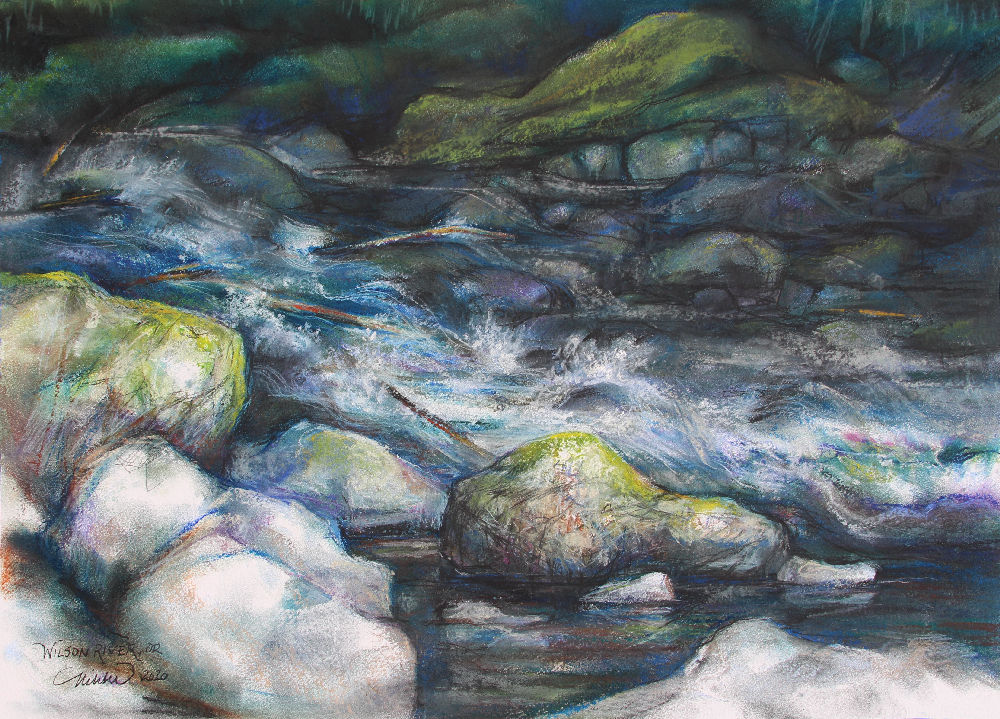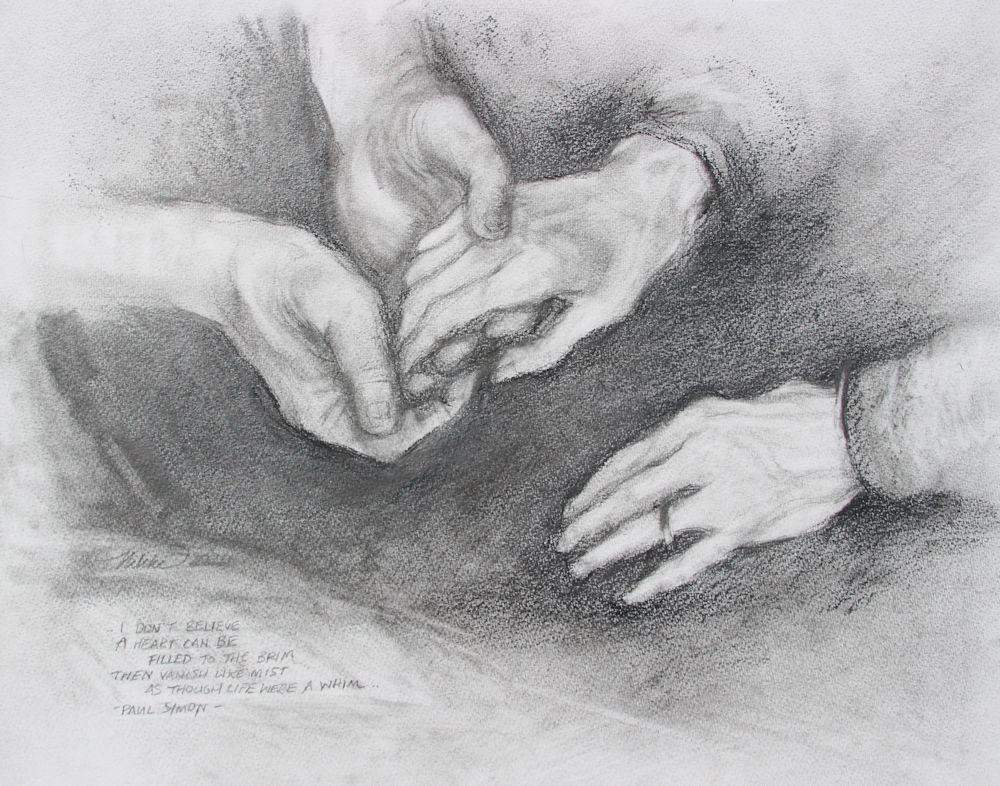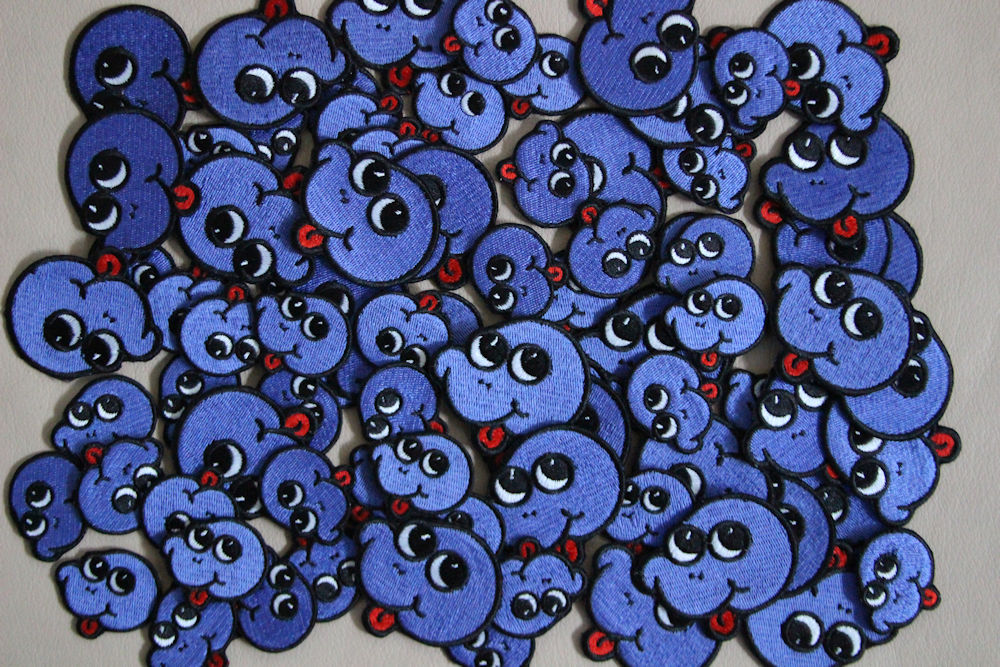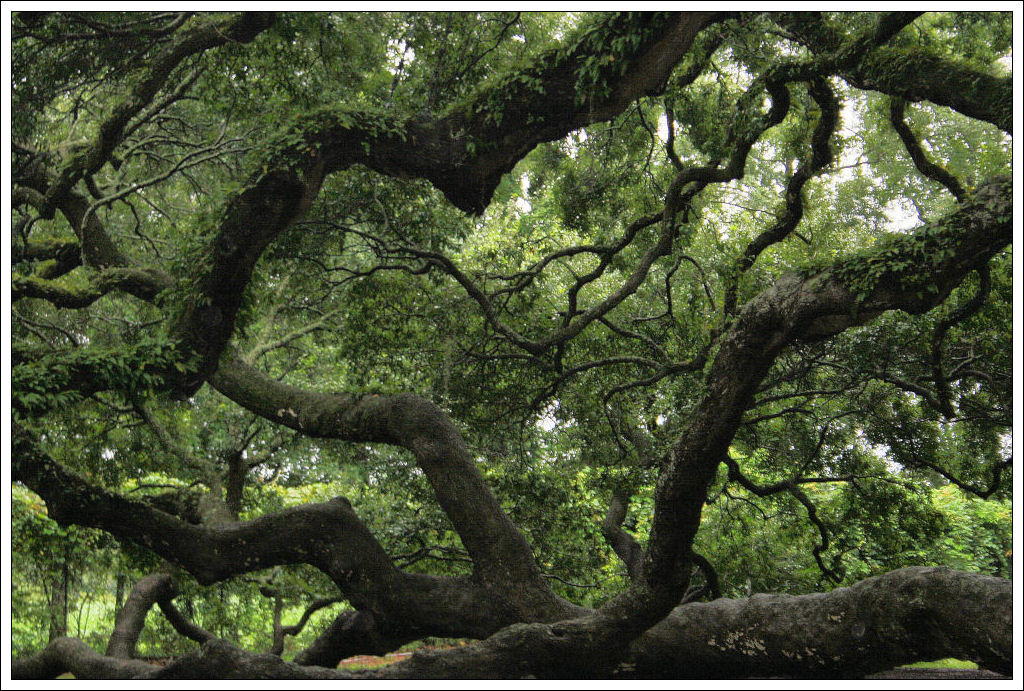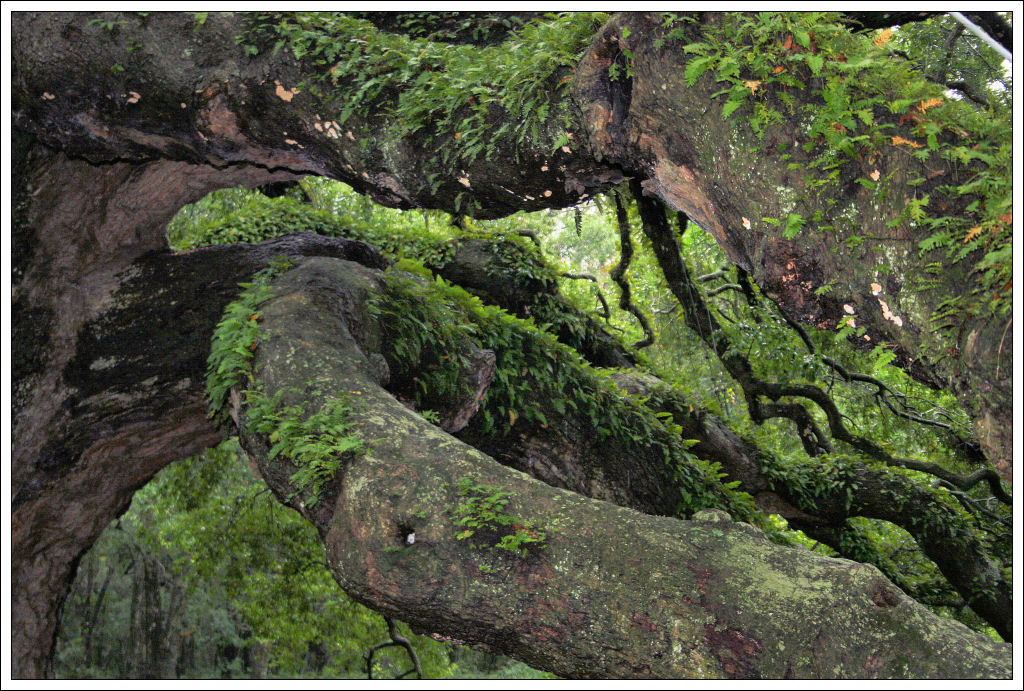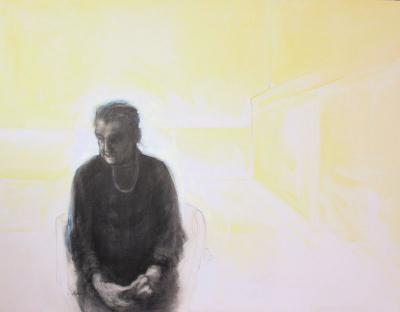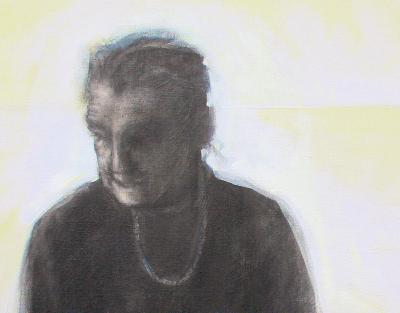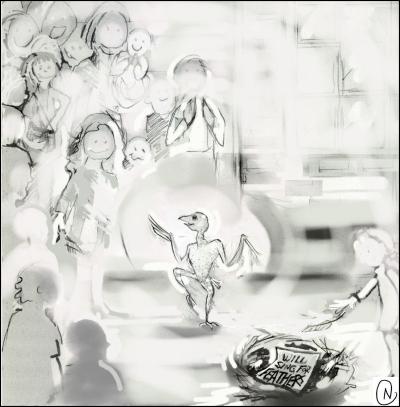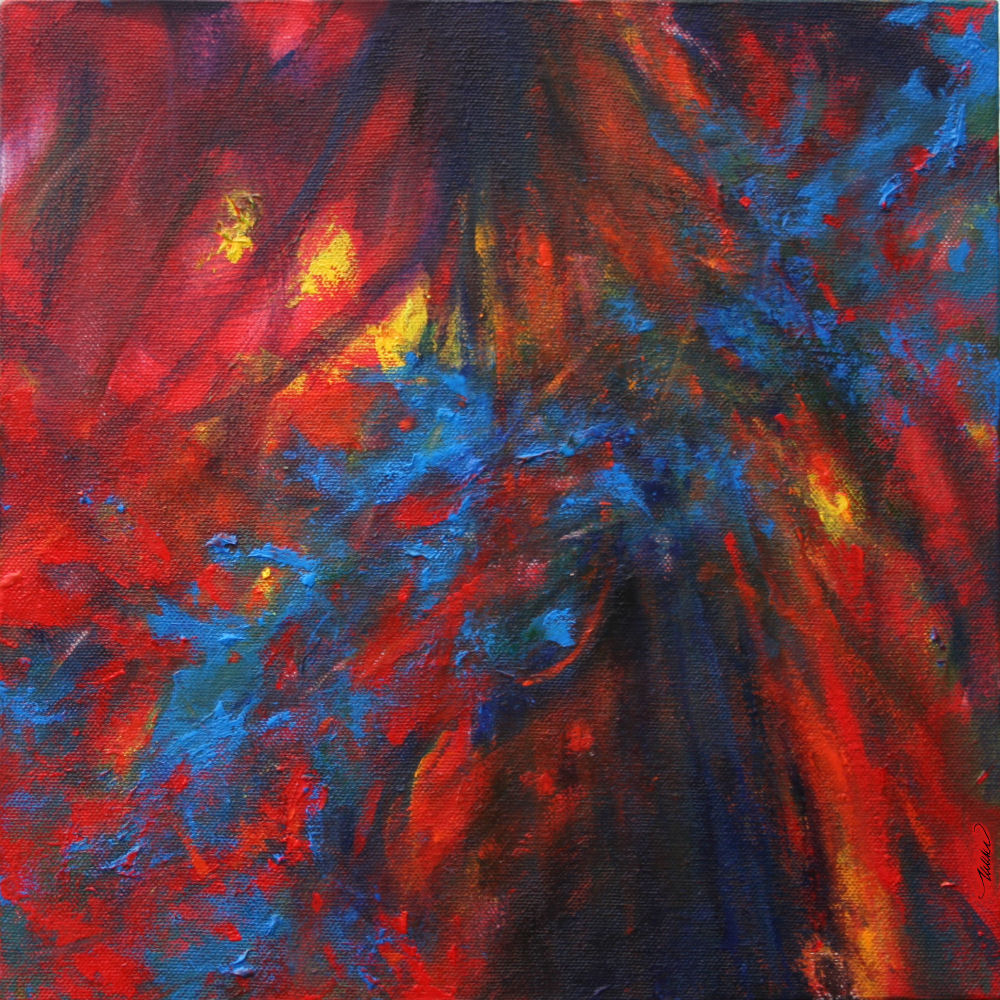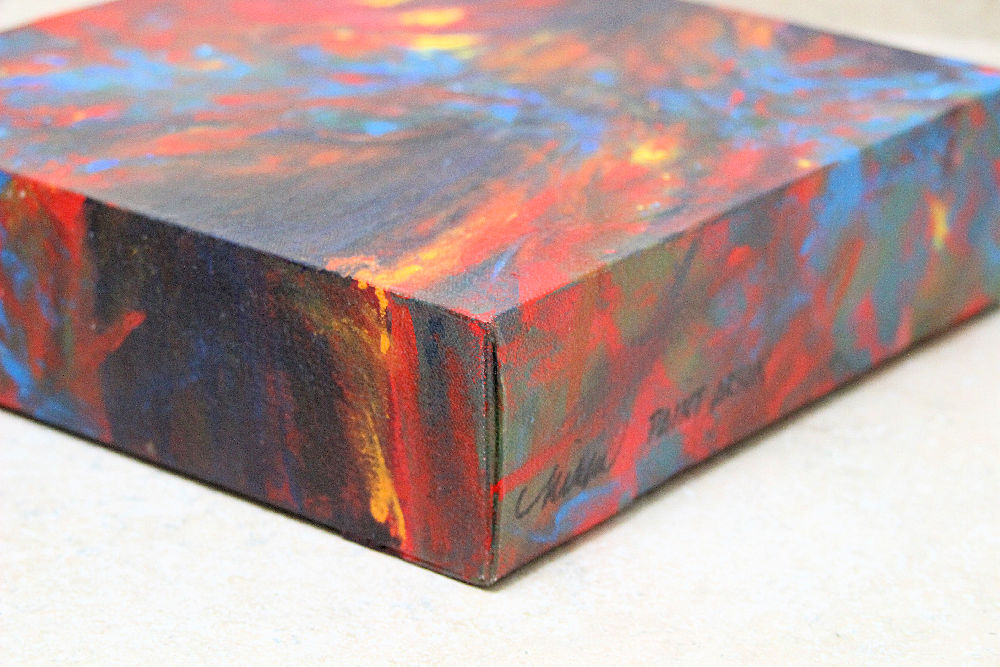Issues
« Previous EntriesAll Water / Seascape Exhibition
Sunday, July 24th, 2022
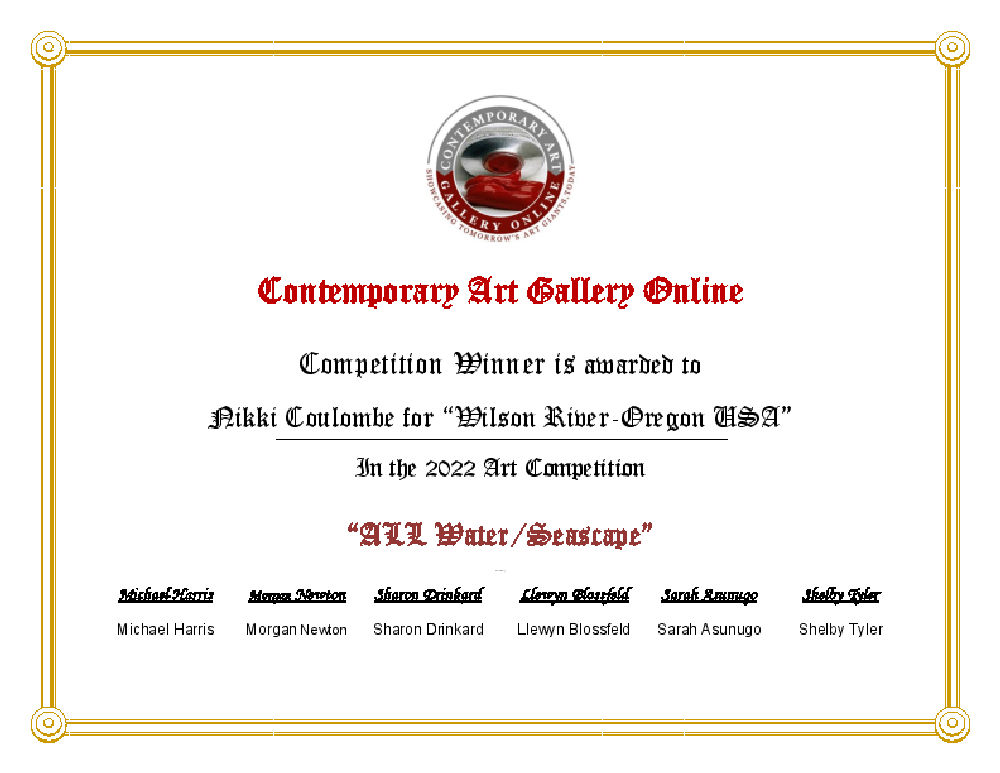 Wilson River, Oregon – 18H x 24W inches soft pastel on 140 lb watercolor paper, framed size 27H x 33W inches, white wood frame, crackle finish.
Wilson River, Oregon – 18H x 24W inches soft pastel on 140 lb watercolor paper, framed size 27H x 33W inches, white wood frame, crackle finish.
Showing online through August-Sept in Contemporary Art Gallery All Water / Seascape Exhibition, along with ‘Trask River’, ‘Microbial Diversity’, and ‘Multnomah Falls’.
(Also showed in the J. Mane Gallery’s ‘Seasons 2020’ exhibition).
English Ivy
Saturday, November 27th, 2021
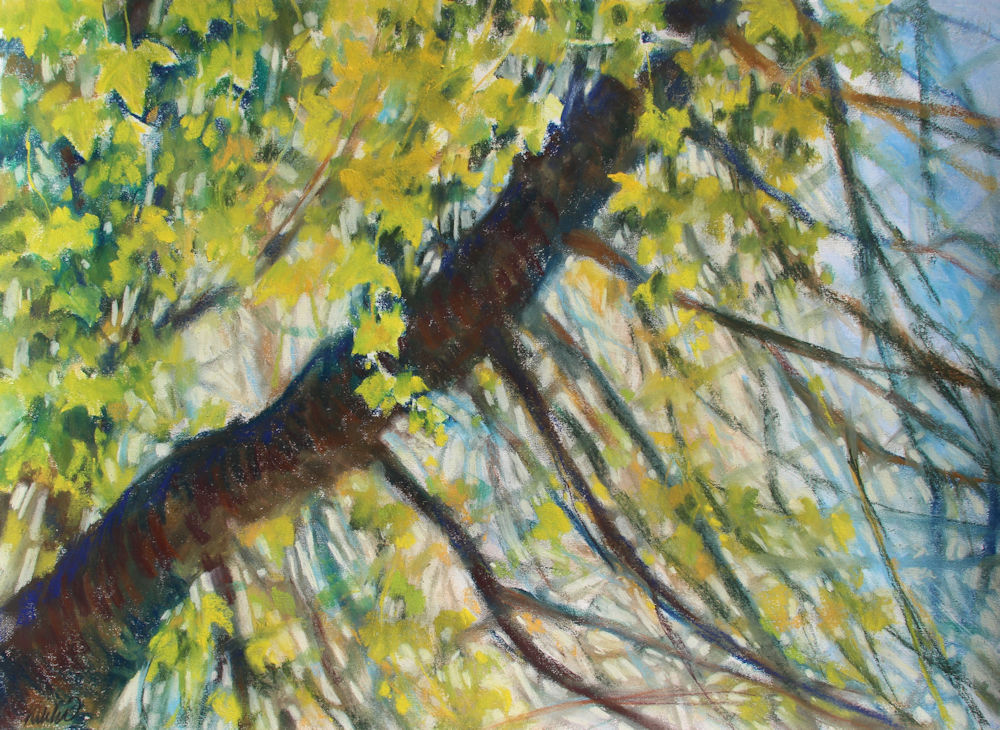
English Ivy drooped in oak tree branches, 18H x 24W inches soft pastels on paper. Framed size 27H x 33W”.
Pretty? Pretty invasive! Probably escaped from a nearby garden, English Ivy is beautiful draped in the branches of this Oak tree, but the plant, left unchecked as a ground cover, will choke out any growth of native or desirable flowers or plants. An aggressive perennial, it attaches easily with roots that exude an adhesive substance, destroying rooves and siding, climbing on branches that break under its weight. Once established, it will kill trees by blocking sunlight and thereby, photosynthesis. Because of the labor and enormous expense it takes to eradicate it from public lands and parks, people are encouraged to not plant this in your garden, even though it’s still for sale in nurseries.
Mom and Dad’s Hands
Monday, July 27th, 2020
Mom and Dad’s Hands, 16H x 20W inches graphite on paper. Excerpt from Paul Simon’s “I Don’t Believe” on the album, ‘Surprise’:
“I don’t believe A heart can be filled to the brim Then vanish like mist As though life were a whim”.
Monte “maskot”
Sunday, April 5th, 2020

 Above: Monte “maskot” face mask for our social responsibility while out and about during COVID19.
Above: Monte “maskot” face mask for our social responsibility while out and about during COVID19.
The Monte Files were listed on my very first website (2003) with the invitation for you, whoever and wherever you are, despite your age or artistic capabilities, to send in your version of Monte or a character inspired by him, and add it to the collection. The invitation still stands.
Your character can be created using any sort of media. Copy any version of Monte in the Monte Files and re-invent him, trace him or print out pages from the Monte Coloring Book at the bottom of the Monte Files page and color or paint it, write a joke or add hand gestures (as in Monte Cycles 2006). There are no rules except have fun with it; Monte’s up for anything!
The pattern I used is here. I found that the suggested interface makes the mask too thick and not porous enough for breathing, so I made some without and they are much more comfortable. It depends on the kind of fabric you’re using, but the mask still holds its’ shape with double-folded fabric.
The Angel Oak, South Carolina
Saturday, April 14th, 2018
This article and set of photos, initially written in 2008 and updated in 2018, honors the tireless efforts to halt construction on John’s Island, South Carolina that would have encroached on an area of land boasting the Oak tree estimated to be 400 to 500 years old. Thanks to conservation and other local groups like schools and churches, individual donors, pro-bono work from lawyers, a sizable grant, and numerous petitions, we are reassured that persistence does make a difference on this planet. The land surrounding the Angel Oak is no longer in jeopardy. Read more about this amazing tree.
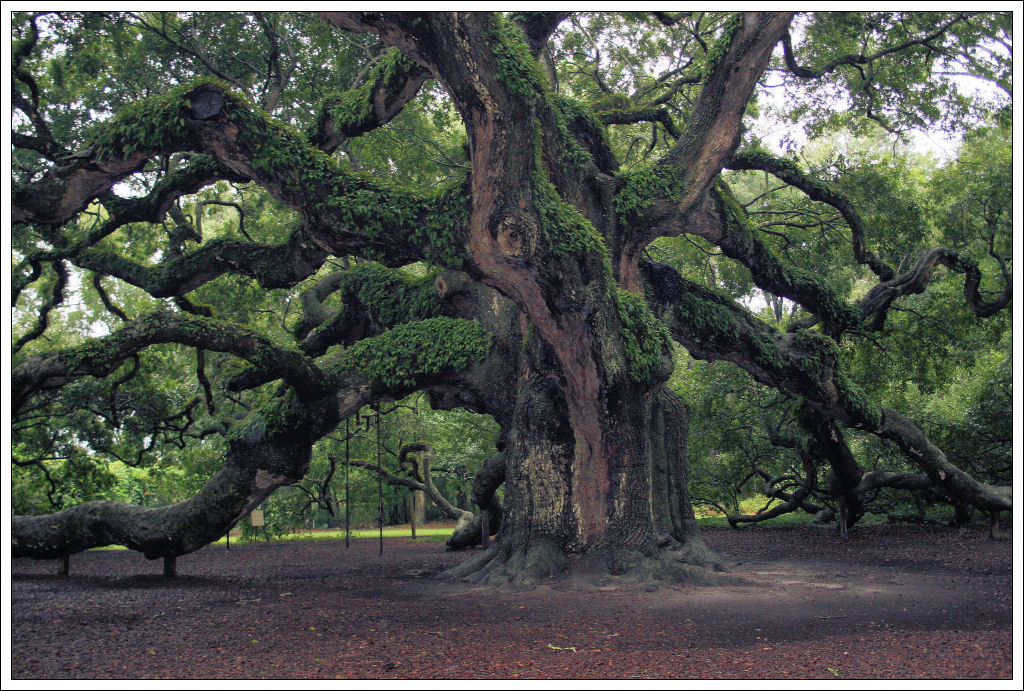 Charleston, SC is proud of its heritage and respected for its commitment to preserving history in the area, and after many years, residents were finally victorious over plans that would have cut down nearby trees and forest in favor of land development.
Charleston, SC is proud of its heritage and respected for its commitment to preserving history in the area, and after many years, residents were finally victorious over plans that would have cut down nearby trees and forest in favor of land development.
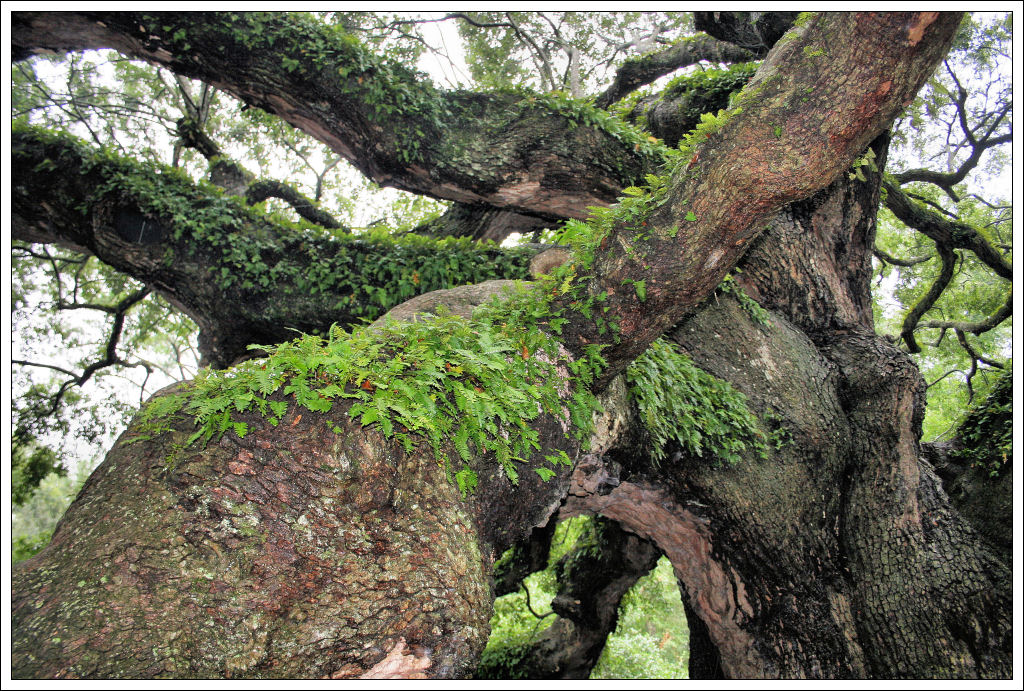 In one 2008 online petition there were hundreds of pages of interesting comments and pleas from residents who have fond memories of climbing the branches as children, plus exclamations written by tourists – national and international – who have visited the area specifically to see the Angel Oak. The tree is so significant to locals, a nearby elementary school carries its name. Picnics, weddings and reunions are held in the Angel Oak Park, including an annual summer Arts event, “Evening under Angel Oak” featuring live music, drama and other activities.
In one 2008 online petition there were hundreds of pages of interesting comments and pleas from residents who have fond memories of climbing the branches as children, plus exclamations written by tourists – national and international – who have visited the area specifically to see the Angel Oak. The tree is so significant to locals, a nearby elementary school carries its name. Picnics, weddings and reunions are held in the Angel Oak Park, including an annual summer Arts event, “Evening under Angel Oak” featuring live music, drama and other activities.
 During August, 2008 my husband and I drove through South Carolina and took a short detour to John’s Island. We drove through wicked rains at the edge of Tropical storm Faye, so when we arrived at Angel Oak Park no one else was there. Although the light was not ideal, fortunately rain subsided long enough to take photos.
During August, 2008 my husband and I drove through South Carolina and took a short detour to John’s Island. We drove through wicked rains at the edge of Tropical storm Faye, so when we arrived at Angel Oak Park no one else was there. Although the light was not ideal, fortunately rain subsided long enough to take photos.
This is one impressive tree! The trunk and lower branches are so immense, they have been propped up with stakes and heavy cables here and there, which is a little intrusive when taking photos, but obviously necessary. Growth is spread outward more than upward. No wonder it is considered sacred by the locals… there is an appreciable presence felt while standing silently under its canopy, which apparently occupies 2,000 yards of space above.
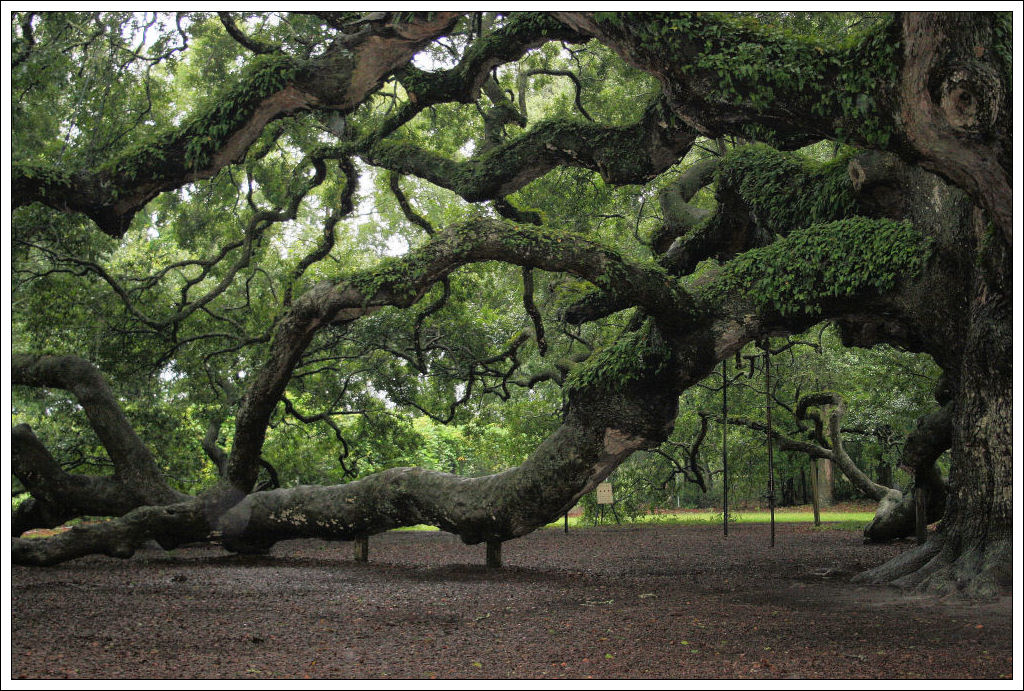 It occurred to me that this tree has lived through one serious chunk of history, and I wondered what was happening on our planet when it was knee-high to an acorn? The Angel Oak’s parent-tree and surrounding forest flourishes for eons before one special acorn falls from one of the magnificent Oaks on the southeastern shores of a land only known to the indigenous peoples then. The acorn sprouts along with many others, but this one will outlive the rest, seasoning hurricanes, climate changes, human encroachment and wars.
It occurred to me that this tree has lived through one serious chunk of history, and I wondered what was happening on our planet when it was knee-high to an acorn? The Angel Oak’s parent-tree and surrounding forest flourishes for eons before one special acorn falls from one of the magnificent Oaks on the southeastern shores of a land only known to the indigenous peoples then. The acorn sprouts along with many others, but this one will outlive the rest, seasoning hurricanes, climate changes, human encroachment and wars.
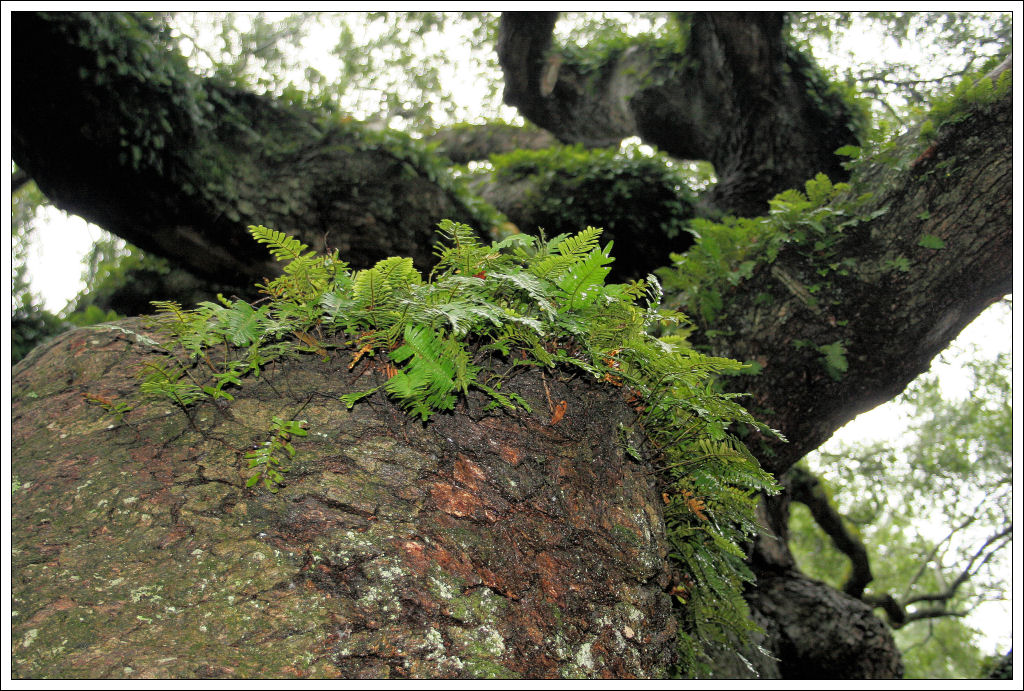 Much of what we are familiar with; our collective modern identity has been shaped by the events and people who lived and died since the Angel Oak established its first roots in the earth. If trees could talk…!
Much of what we are familiar with; our collective modern identity has been shaped by the events and people who lived and died since the Angel Oak established its first roots in the earth. If trees could talk…!
The Angel Oak does not exist on its own. It depends on the surrounding forest, so any deliberate disturbance in the immediate soil or neighboring properties would disrupt its far-reaching and delicate root system. Thankfully, now the tree will remain host to a myriad of life forms, supporting an abundant, specialized ecosystem of mosses, fungi and fern varieties, insects and amphibians – hopefully for five hundred more years. The Angel oak lives on as one of the true jewels on this planet.
While older, poorer quality photos are still gradually being replaced, the Majesty of Trees / Dancing with Trees exhibition website is now updated. Check it out!
Toil and Peaceful Life
Wednesday, July 7th, 2010
“Art is a human activity having for its purpose the transmission to others of the highest and best feelings to which [humanity has] risen.”
Leo Tolstoy
Creating art is always a personal endeavour, and every so often I’m drawn to study only for the deeper experience of it; for the kind of education and understanding that can’t come through reading or any other means. Here is a painting I started in May, along with links and information about a unique part of Canadian history that many Canadians are not even aware of, a group of Russian immigrants who made significant contributions to, and the development of, the Canadian prairies. Next week I’ll be driving up to Alberta through Blaine Lake, Saskatchewan where some of the Doukhobors, whom I’ve just recently learned are part of my own heritage, settled during the 19th century. Upon returning from this final leg of summer travel there is another painting commission to complete, so I’ll be blogging regularly again and finishing this painting in about two months.
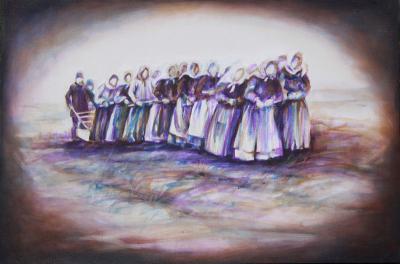
“Toil and Peaceful Life” (quote, Peter V. Verigin), 24 x 36 x 2 inches acrylics on canvas. Study only, NFS, work in progress: There are harsh contrasts and colors at this stage, so am planning to paint over the whole surface with my friend Virginia’s white wash formula (1/2 guesso, 1/4 matte medium and 1/4 water), then will gradually bring out details again by scrubbing areas away with a wet cloth and repainting as well. Further layers of siennas, umbers, pale yellows, unbleached titanium washes etc. will be treated the same way.
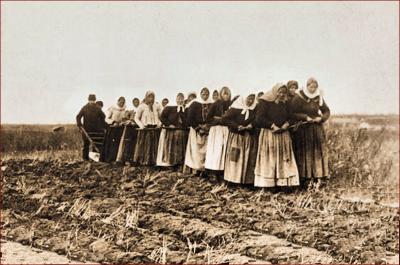 When the light bulb on my sewing machine burnt out – it won’t work without one – I could have hopped in the car and driven three blocks to go buy another, but instead made due hemming a garment by manually spinning the wheel on the machine. I had already started the above painting referring to an old photo of 16 Doukhobor women pulling and two men directing a plow as they tilled the land in southern Manitoba, Canada’s eastern-most prairie province, during the late 1800’s. This is one of the more powerful images portraying the character of the Doukhobors, who left their homeland in Russia because of religious persecution, never allowed to return, becoming the largest mass immigration in Canadian history.
When the light bulb on my sewing machine burnt out – it won’t work without one – I could have hopped in the car and driven three blocks to go buy another, but instead made due hemming a garment by manually spinning the wheel on the machine. I had already started the above painting referring to an old photo of 16 Doukhobor women pulling and two men directing a plow as they tilled the land in southern Manitoba, Canada’s eastern-most prairie province, during the late 1800’s. This is one of the more powerful images portraying the character of the Doukhobors, who left their homeland in Russia because of religious persecution, never allowed to return, becoming the largest mass immigration in Canadian history.
I’ve often wondered how it must have been for women in the past, considering all of the chores that raising a family and taking care of the home must have entailed. On top of that, there was little relief from extreme weather conditions as, for example, during the heat of summer all of these responsibilities were done wearing long dresses, petticoats and bonnets. I guess it was with this in mind that I endured impatiently sewing my jeans without electricity.
The small amount of soil I turn over in the garden is planted mostly with flowers. The few veggies that are novel to watch grow from seed to fruition are not crucual to the survival of my family. While I’m purchasing ready-wound thread on a plastic bobbin, I can select from a number of food choices and shop during any time of day, 24 hours a day in a 7 day week. Todays’ lifestyles are so far removed from the realities that pioneers in any land must have faced. Living in small communities where all could share the work as well as morally support each other made complete sense. So it was for the Doukhobors, living a philosophy very similar to the Hutterites, the Mennonites, and the Amish.
Photos are photos and paintings are paintings, but as traditional artists we can take advantage of the art of photography as inspiration to trigger motivation and memories, recreate impressions, and refer to for details. If photos are used as reference, very soon after painting begins I rely on and respond more to what’s happening on the canvas. For some time before putting brush to canvas, every detail of a subject adds to an internal mental picture, one that gradually envisions the painting finished to a certain degree. In some cases I’ll work from pictures of historic art or artifacts as educational studies, or from a client’s photo if they commission the reproduction of a favorite scene. Always though, the resulting art is an emotional translation.
The first thing that strikes me in the enlarged re-re-reproduced print I’m working from is how little the quality of the image matters. The shadows on the faces of each individual say it all. Some appear curious about having their photo taken, and most are more concerned about the task at hand. Though the image is crude by modern standards, and maybe even partly due to it, we are able to share the raw truth of a moment in one of an uncountable number of cultures throughout human history who worked so physically this way. For most of our time here on earth, we, like all of nature, knew we depended on the land, and it truly was survival of the fittest. I can only hope to capture the calibre of this story as well as the photo does.
Sometimes a painting can never be as effective as a photo, particularly when it comes to human portraits. In intances like this, there is so much value in “the journey” of your efforts. Painting such a scene, it really is like being transported. Of course the goal is to make the work successful, and artists all hope and plan for sales, but we also need to make time for creating work that feeds our soul and brings us back to the inner sources that pulled us into this not-always-externally-fulfilling vocation in the first place. When I recommend forgetting the rules and listening to your own, that’s what I mean. Even if you have never tried to paint or draw before, or you think you don’t have enough skill, you are as capable as anyone if you are spurred on by your emotions toward subjects you love, using whatever methods you enjoy.
Facebook – group intro:
“Toil and Peaceful Life”
The name Doukhobor means “spirit wrestler”. Although many of their beliefs descended from Christianity, being a Doukhobor is more of a way of life than a religion. Doukhobors are a group of pacifists that came to Canada from Russia to escape persecution for their beliefs at the end of the 19th century. The most well known leader of the Doukhobors was Peter ‘Lordly’ Verigin. The Doukhobors established communites across Western Canada, many times cultivating land that was not seen as desirable. There are still reminants of Doukhobor villages primarily in British Columbia and Saskatchewan.
“…The settlers found Saskatchewan winters much harsher than those in Transcaucasia, and were particularly disappointed that the climate was not as suitable for growing fruits and vegetables. Many of the men found it necessary to take non-farm jobs, especially in railway construction, while the women stayed behind to till the land…”
Susan Wiley Hardwick, “Russian Refuge: Religion, Migration, and Settlement on the North American Pacific Rim”. University of Chicago Press, 1993. ISBN 0-226-31610-6. 1993. Section “The Doukhobors”
http://en.wikipedia.org/wiki/Doukhobor
The Doukhobors: 16th Century Russia to Canada, 2010
The origin of the Doukhobors is fairly dubious, but some information dates the culture back to 16th and 17th century Russia. Deeply spiritual, the “Doukho-borets”, which literally means “spirit wrestlers”, rejected common orthodox practices of organized religions and society, including the worship of icons and individual land ownership. As pacifists, their motto was “Toil and Peaceful Life”.
After refusing allegiance to Tsar Nicholas and military service, in 1895, they burnt all of their weapons in response to this. (The date, June 28th, has become a day of celebration of their humble roots.) Facing persecution for their beliefs, over 7,000 Doukhobors sought refuge in Canada starting in 1899.
The Doukhobors’ passage across the Atlantic Ocean was largely paid for by Quakers and Tolstoyans, who sympathized with their plight, and by the writer Leo Tolstoy, who arranged for the royalties from his novel Resurrection, his story Father Sergei, and some others, to go to the migration fund. He also raised money from wealthy friends. In the end, his efforts provided half of the immigration fund, about 30,000 rubles.
* Multicultural Canada http://multiculturalcanada.ca/node/48207
With sympathy from the Canadian government, for a $10 fee each adult male was intitially provided with 160 acres of “free land” on the prairies of central Canada; present day Saskatchewan and Manitoba. They were expected to live on and break the land, plant crops, and eventually apply for a patent to own it.
During 1906, a new Parliamentary Minister revised their previous agreement to laws that commanded a pledge of allegiance to the Crown or else lose their homesteads. In 1907, 2,500 homesteads were cancelled, causing communal splits into three distinct groups. The largest group of Doukhobors, incuding Peter Verigin, the man who had re-documented and defined their Orthodox faith, moved to British Columbia. The “Sons of Freedom” also went to B.C., but were radically different than the Community Doukhobors. They actively protested (sometimes nude!) issues arising from Canadian governmental control over their way of life, creating misunderstandings and negativity toward Doukhobors in general that remain to this day. The “Independents” maintained their homesteads in Saskatchewan in compliance with the new Canadian laws.
1908 to 1912: Peter Veregin’s group purchased land in the West Kootenays, B.C. and developed large communal enterprises. The Doukhobors now call themselves the Christian Community of Universal Brotherhood (CCUB), situated in Brilliant, B.C..
Video http://www.youtube.com/watch?v=Kp5umD3HA8k
A Heart Filled to the Brim
Sunday, January 17th, 2010
A Heart Filled to the Brim, 36H x 48W x 2D inches, water soluble graphite, acrylics on canvas. On exhibit along with Polypore Fungi February through May at the Oxide Gallery, Denton, Texas
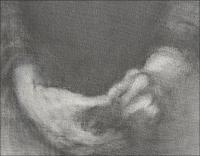 An excerpt from the song, I Don’t Believe by Paul Simon on the CD, Surprise:
An excerpt from the song, I Don’t Believe by Paul Simon on the CD, Surprise:
I don’t believe a heart can be filled to the brim
then vanish like mist as though life were a whim.
Maybe the heart is part of the mist
And that’s all that there is and could ever exist.
A portrait of Alzheimer’s honoring my Grandmother, my Mother-in-law (whose portrait this is, and whose 80th birthday is in two days), and now recently my own Mother who is in the earliest stages; and with empathy for all those afflicted, including the families dealing with the awful emotional reverberations caused by this disease.
Here are a few websites providing information about Alzheimer’s Disease
http://www.alz.org/index.asp
http://www.alzheimersrxtreatment.com/learnaboutalz.html
http://www.alzheimers.org/
Basic pricing strategies: Artists and the economy
Thursday, September 17th, 2009
How do artists price their work? How do artists price their work honestly, consider themselves as legitimate business persons, still with equal regard to the buyer looking for quality and a fair deal? How do artists price their work reasonably while acknowledging the responsibility we have to our trade; that is, respecting that we, in many cases, base our prices on each other’s? How do artists price their work while competing other artists, when for some, savvy marketing skills yield profits far higher than the quality of their art? (Subjective as art is, we all recognize quality…or do we?). How do artists price their work to sell in a dicey economy? How do artists price their work to sell in a dicey economy that’s dependent on the moral and ethical whims of public spending, and the consequential extremes of society?
 I have just reluctantly slashed the prices on my artwork. I’m not going to soften the announcement with a less violent description, because compromising what I feel are well-earned wages, whether adapting to economic conditions or sharing a percentage of it for any reason, is brutal. My canvases are not the only ones feeling the brush of reality these days though; I see, hear and read that a lot of artists are reevaluating how much they ask for their work. Still, I applaud those artists who continue to stand up for the principles of the unspoken “Artist’s Code”, as Homer Simpson might put it. I’m not fond of unsold art accumulating and spilling out into every room of my home though. The hope is that it will resonate with someone else besides me. It must be seen and it must be shared.
I have just reluctantly slashed the prices on my artwork. I’m not going to soften the announcement with a less violent description, because compromising what I feel are well-earned wages, whether adapting to economic conditions or sharing a percentage of it for any reason, is brutal. My canvases are not the only ones feeling the brush of reality these days though; I see, hear and read that a lot of artists are reevaluating how much they ask for their work. Still, I applaud those artists who continue to stand up for the principles of the unspoken “Artist’s Code”, as Homer Simpson might put it. I’m not fond of unsold art accumulating and spilling out into every room of my home though. The hope is that it will resonate with someone else besides me. It must be seen and it must be shared.
Andy Warhol said: “Art is what sells”.
Maybe the average art enthusiast doesn’t know how we derive prices for our work. Maybe many artists don’t stop to dissect their decisions either. The prices of art in galleries worldwide are inconsistent, confusing and often irrational, and who is authorized to price artwork like that anyway? (Ideally it should be the artist). There are so many variables. I’m probably going to miss naming a few here because methods for pricing vary from artist to artist, hobby or career, and if their art is in the form of products or services. Costs of materials and time spent are considered, and price differences with regard those two factors have everything to do with the quality of time spent and quality of materials. Skill levels, concepts, originality, to some extent size, (ie. sculptures, murals), and if it’s for sale in a home studio in Rocky Mount, North Carolina or a high-end gallery in New York City…and most artists will tell you that above all, the final price has to “feel” right. For some strictly structural Art-minds, feelings in art don’t have a leg to stand on – but in actual fact they have two legs (the human thing). The most unpredictable, nonsensical thing is that even if the artist makes an impact while alive, their older work may be worth much less than the most recent, but when the artist dies, prices of their earliest works may increase.
Will Sing For Feathers, 8 x 10 inches, traditional graphite drawing scanned, drawn digitally, printed, process repeated
As we gain experience, confidence toward change and experimentation, and progressively improve our development as Artists, theoretically we should be able to charge more, which is why “mature” artists naturally feel they deserve to be paid more. Case in point: me. The price I initially wanted to charge for “Dancing With Trees” was $7,500.
It seems like a lot to be asking for those unfamiliar with all that painting or other forms of artwork involves. Time seems to be the most accountable factor in producing it. After viewing the artwork and the price, the most common question is: How long did that take you? It’s a fair question, because for most jobs, time input equals amount charged; a predictable amount of money is paid in exchange for a certain amount of labor within a set amount of time. If only it were that simple.
Using that system to price then, Dancing With Trees is my very best work to date, and it took almost 50 years to learn how to paint it. The price was reduced from $7,500.00 to $5,500.00. Assuming I don’t have to share a percentage of that figure with a gallery, and assuming it sells in the next year, that works out to approximately .7638888888888889 cents per hour. I feel confident that it’s worth that much. That’s a wage about as kookoo as a bird dancing for its own feathers. One day someone will come along who has an extremely large wall and agrees that the painting is worth .7638888888888889 cents per hour, and they will buy it. Each year work hangs around with me though, I decrease the asking price as new pieces are created.
Sometimes I wish I was just a bird!
The vocation of Artist is a calling, and a journey of personal growth. Who doesn’t want to do what they love, learn all the time, contribute the best they have to offer to the world, and earn a living as well? Creativity is not only what we love to do; it is a deeply-rooted habit, a compulsion and an addiction of the very best kind. Art is connected intimately with our lives so we continue to make “stuff” no matter what, and preferably, the artists’ judgment of its’ value will be trusted. In my revised Price List I’ve made a good effort to be fair to the buyer while at the same time remaining true to myself.
Post script, 2016: Well, such is life — due to the economy, and a taste of humble pie, I have since lowered the price of Dancing With Trees 03 to $1,100. It’s still substantial enough to pay for my time and material costs, and perhaps more in tune with the reality of art sales expectations these days.
Peace is Breaking Out Everywhere
Thursday, September 10th, 2009
 “If we could eradicate poverty and give people a sense of worth,
“If we could eradicate poverty and give people a sense of worth,
a great deal of conflict would end. It would not even begin.
Why are we so stupid for so long?”
Bishop Desmond Tutu
Paint Arson
Thursday, March 26th, 2009
Paint Arson, 11H x 11W x 3D inches acrylics on canvas, wrapped sides painted.
Frame unnecessary. Hang on a wall or display on a flat surface. Signed on the side so as not to impose on the composition.
Progress and process phases 1 and 2 images.
Painting, whatever the subject may be, is a journey through all kinds of unanticipated thoughts and associations; some are short and sweet, ending within 1 – 6 hours and not much more than a visual, but some are packed full of adventure that isn’t even realized until surfacing from a few hours of work.
A new jar of Cadmium Red medium hue was just the thing to reboot, then re-route some old habits I was falling back into, like over-working paintings. Trying a new color invigorates the work process like nothing else can, adding certain life to the results as well. Incorporated as a base, straight out of the tube or mixed with your usual palette, a new color can change everything.


